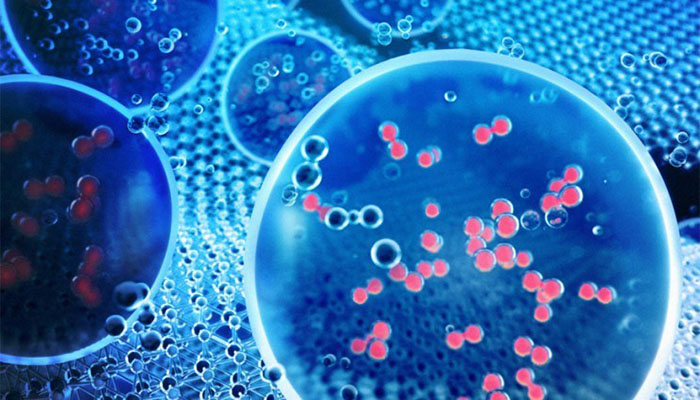Materials scientists at LLNL are integrating high-fidelity simulations, high-performance computing, and in situ experiments to accelerate materials development for hydrogen production.
The rise of hydrogen fuel
Hydrogen is the most abundant element in the universe and a basic component of water, along with oxygen. Hydrogen can be used as a clean fuel in fuel cells, which produce power with only water and heat as byproducts, and the market for hydrogen fuel cell vehicles has been steadily growing.
Though hydrogen can be produced from multiple sources, researchers aim to make it from only water and sunlight. The main challenge to this approach is simultaneously improving the stability and efficiency of the device that performs the task, as many of the most efficient photoabsorbing materials, such as silicon and indium phosphide, are often unstable under photoelectrochemical operating conditions.
Integrating simulation and experiments for materials design
With support from the Hydrogen Advanced Water Splitting Materials Consortium (HydroGEN), we have developed and applied novel simulation and modeling techniques to understand and accelerate materials development for hydrogen production. Within HydroGEN, we lead several modeling and simulation efforts, where we have largely focused on advancing the understanding of complex materials interfaces relevant for hydrogen production.
Our team leverages LLNL’s high-performance computing capabilities to address the main challenges in advancing materials for hydrogen production. In particular, we seek to develop:
- Novel simulation techniques for elucidating the interplay and coupling between chemistry, electronic structure, and catalytic activities.
- Methods for integrating atomistic and mesoscale modeling and characterization experiments.
- Fundamental understanding of physicochemical processes that govern the efficiency and stability of materials for hydrogen production under operating conditions.
Our efforts are highly integrated with characterization and synthesis activities at LLNL, as well as those at several global universities and other national laboratories. For example, our researchers, along with colleagues at Notre Dame University and Lawrence Berkeley National Laboratory, have developed an integrated theory–experiment technique to interrogate chemistry at solid/liquid interfaces. This technique has been applied to understand oxides formed on gallium phosphide and indium phosphide surfaces under conditions relevant to photoelectrochemical hydrogen production.
The research is sponsored by the Fuel Cell Technologies Office within the Department of Energy’s Office of Energy Efficiency and Renewable Energy.
Publications
T. Smart, T.A. Pham, Y. Ping, T. Ogitsu, Optical Absorption Induced by Small Polaron Formation in Transition Metal Oxides-The Case of Co3O4, Phys. Rev. Mat. 3, 102401 (2019).
N. Gaillard, D. Prasher, M. Chong, A. Deangelis, K. Horsley, H. Ishii, J. Bradley, J. Varley, T. Ogitsu, Wide-Bandgap Cu(In,Ga)S2 Photocathodes Integrated on Transparent Conductive F: SnO2 Substrates for Chalcopyrite-Based Water Splitting Tandem Devices, ACS Appl. Energy Mater. 2, 5515 (2019).
J.B. Varley, V. Lordi, T. Ogitsu, A. Deangelis, K. Horsley, N. Gaillard, Assessing the role of hydrogen in Fermi-level pinning in chalcopyrite and kesterite solar absorbers from first-principles calculations, J. Appl. Phys. 123, 161408 (2018).
T.A. Pham, X. Zhang, B.C. Wood, D. Prendergast, S. Ptasinska, T. Ogitsu, Integrating ab initio simulations and x-ray photoelectron spectroscopy: Toward a realistic description of oxidized solid/liquid interfaces, J. Phys. Chem. Lett. 9, 194 (2018).
D.V. Esposito, J.B. Baxter, J. John, N.S. Lewis, T.P. Moffat, T. Ogitsu, G. O’Neil, T.A. Pham, A.A. Talin, J. Valazquez, B.C. Wood, Methods of photoelectrode characterization with high spatial and temporal resolution, Energy Environ. Sci. 8, 2863 (2015).
B.C. Wood, E. Schwegler, W.I. Choi, T. Ogitsu, Surface chemistry of GaP(001) and InP(001) in contact with water, J. Phys. Chem. C 118, 1062 (2014).
B.C. Wood, E. Schwegler, W.I. Choi, T. Ogitsu, Hydrogen-Bond Dynamics of Water at the Interface with InP/GaP(001) and the Implications for Photoelectrochemistry, J. Am. Chem. Soc. 135, 15774 (2013).
B.C. Wood, T. Ogitsu, E. Schwegler, Local structural models of complex oxygen- and hydroxyl-rich GaP/InP(001) surfaces, J. Chem. Phys. 136, 064705 (2012).
People
Learn more about hydrogen production
- Looking to the sun to create hydrogen fuel (LLNL news, January 17, 2018)
- It’s something in the water: LLNL scientists extract hydrogen as potential fuel source (LLNL news, July 31, 2017)
- Diving into the Dynamics of Evolving Hydrogen (Science & Technology Review, April 2015)
- Livermore team awarded for hydrogen production research (Physical and Life Sciences news, August 28, 2014)






